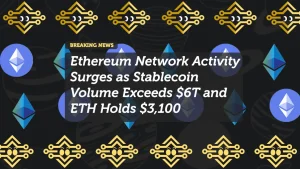
Restaking and EigenLayer: Unlocking Ethereum’s Security Potential or a Risky Bet?
Ethereum’s transition to Proof-of-Stake (PoS) in 2022 brought new ways for users to earn rewards by securing the network. But what if those staked ETH tokens could do even more? That’s the idea behind restaking, a rapidly growing concept powered by EigenLayer. It allows staked ETH to be “reused” to secure additional protocols, earning extra rewards.
While this could strengthen Ethereum’s role as the backbone of Web3, some critics argue it introduces excessive risk. Let’s break down how restaking works, its benefits, and the potential dangers.
What is Restaking?
Restaking builds on Ethereum’s PoS model, where validators lock up ETH to secure the network and earn annual yields of 3-5%. Traditionally, that staked ETH only secures Ethereum’s blockchain. Restaking allows validators to extend their security role to other protocols—like rollups, oracles, and decentralized applications—while keeping the ETH locked in Ethereum’s staking system.
Think of it as lending out your staked ETH’s security power without unstaking it. This unlocks additional revenue streams for stakers and provides smaller protocols with Ethereum-grade security, reducing the need for them to bootstrap their own validator networks.
While Polkadot has experimented with shared security, Ethereum’s EigenLayer has taken the concept to a whole new level.
How EigenLayer Enables Restaking
EigenLayer is a smart contract-based marketplace that lets Ethereum stakers “opt in” to provide security to third-party projects. Here’s how it works:
1. Stake ETH as Usual
Validators or liquid staking users (e.g., those using stETH from Lido) lock their ETH to secure Ethereum.
2. Opt into EigenLayer
Users agree to restake their staked ETH, allowing EigenLayer to allocate that security to external protocols.
3. Secure Additional Protocols
Developers building rollups, oracles, cross-chain bridges, or even new blockchain layers can “rent” this security from EigenLayer instead of setting up their own validator network.
4. Earn Extra Rewards
Validators receive additional incentives—often in the form of native tokens or ETH—from the protocols they help secure.
EigenLayer acts as the middleman, enforcing slashing conditions (penalties for misbehavior) and ensuring that staked ETH is used correctly.
The Key Players in EigenLayer’s Ecosystem
Operators
These are the validators or node operators who perform the actual work of securing external protocols using restaked ETH. Stakers delegate their ETH to these operators.
Actively Validated Services (AVSs)
These are the protocols borrowing Ethereum’s security via EigenLayer. Examples include:
- Rollups (e.g., Arbitrum-like networks that scale Ethereum)
- Oracles (providing reliable off-chain data to smart contracts)
- Bridges (cross-chain solutions that connect different blockchains)
Each AVS defines its own slashing rules—so if an operator fails, some of the restaked ETH could be penalized.
Why Restaking is Exciting
1. Higher Yields for Stakers
Instead of earning just 3-5% from Ethereum staking, restakers can boost their returns to 5-10% or more, depending on how many AVSs they secure.
2. Cost-Effective Security for Developers
Launching a secure blockchain or rollup usually requires a massive validator network. EigenLayer allows projects to borrow Ethereum’s existing $100B+ in staked ETH for security, significantly reducing costs.
3. Strengthening Ethereum’s Network Effect
If EigenLayer becomes the dominant security marketplace, Ethereum’s ecosystem will grow even larger, making it the go-to foundation for Web3 applications.
4. Unlocking Innovation
Restaking allows smaller projects to launch with Ethereum-grade security, potentially accelerating the development of new rollups, DeFi applications, and Web3 infrastructure.
The Risks of Restaking
1. Over-Leveraging Ethereum’s Security
If a single staked ETH is securing multiple protocols, what happens if one of them collapses?
- A catastrophic failure could lead to widespread slashing, wiping out stakers’ funds.
- This could trigger a contagion effect, damaging confidence in Ethereum’s staking system.
2. Centralization Concerns
- Liquid staking protocols like Lido already control over 30% of staked ETH.
- If these platforms also dominate restaking, Ethereum’s validator set could become increasingly centralized, weakening the network’s decentralization.
3. EigenLayer’s Systemic Risk
- If EigenLayer becomes the default security layer for multiple projects, a failure in EigenLayer itself could ripple across the entire Ethereum ecosystem.
- Critics argue that too many protocols relying on EigenLayer is similar to “too big to fail” scenarios in traditional finance.
4. Regulatory Uncertainty
- The U.S. SEC and other regulators may classify EigenLayer’s staking model as a securities offering, leading to potential legal challenges.
- A crackdown on liquid staking derivatives (LSDs)—such as Lido’s stETH—could limit restaking’s accessibility.
Ethereum co-founder Vitalik Buterin has warned against overextending Ethereum’s consensus layer. He has suggested limiting restaking to prevent systemic risks, arguing that EigenLayer could introduce unintended vulnerabilities.
What’s Happening in 2025?
1. EigenLayer’s TVL is Growing Rapidly
As of early 2025, EigenLayer’s Total Value Locked (TVL) is in the billions, showing strong adoption.
2. EigenDA is Gaining Traction
EigenLayer’s decentralized data availability (EigenDA) service is gaining momentum, offering rollups a cheaper alternative to Ethereum’s base layer.
3. Restaking Tokens Emerge
The launch of EIGEN, EigenLayer’s native token, has sparked both excitement and controversy.
- It is used for governance and rewarding participants.
- Some stakers are concerned about airdrop distribution and staking limits.
4. Liquid Restaking is Expanding
Protocols like Renzo and Kelp DAO allow users to restake their liquid staking tokens (e.g., stETH), adding yet another layer of complexity—and risk—to the ecosystem.
The Future of Restaking: Innovation or a Bubble?
If Restaking Succeeds:
- Ethereum becomes the security backbone of Web3.
- Developers gain access to high-quality security without massive capital requirements.
- Stakers earn higher, sustainable yields.
If Restaking Fails:
- A security failure in EigenLayer could damage trust in Ethereum.
- Excessive slashing could wipe out stakers’ capital, triggering a liquidity crisis.
- Regulators might step in, limiting or banning certain restaking models.
Conclusion: Is Restaking Worth It?
Restaking and EigenLayer present a groundbreaking but high-risk innovation for Ethereum. While it offers higher rewards and scalability, it also introduces systemic risks and potential centralization concerns.
For now, EigenLayer is still an experiment—one that could redefine Ethereum’s security model or become a cautionary tale of over-leverage. Whether restaking strengthens Ethereum or stretches it too thin remains an open question.
Would you stake your ETH into EigenLayer, or do the risks outweigh the rewards? Let’s discuss.
















